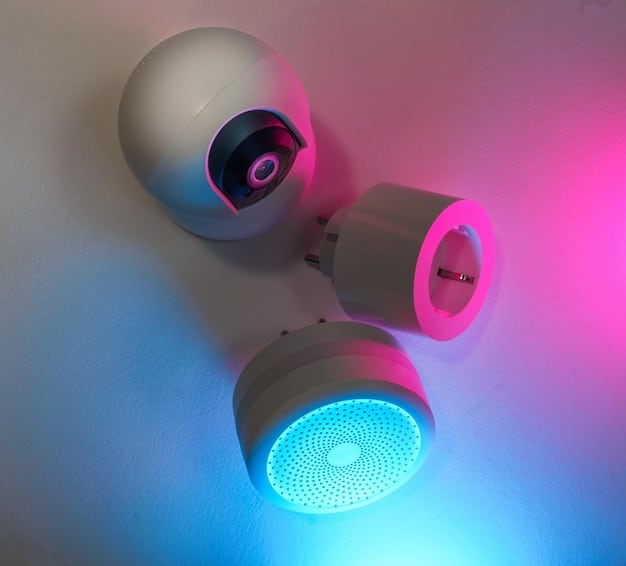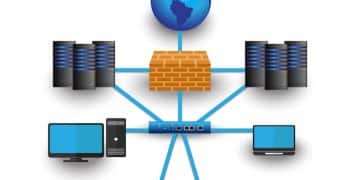Secure Your IoT: A Practical Guide to Cyber Threat Protection

Securing your IoT devices from cyber threats involves a multi-layered approach, including strong passwords, regular software updates, network segmentation, and implementing robust security protocols to safeguard sensitive data and prevent unauthorized access.
The Internet of Things (IoT) has woven itself into the fabric of our lives, connecting everything from smart thermostats to industrial control systems. However, this increased connectivity also expands the attack surface for cybercriminals. This is where understanding how to secure your IoT devices from cyber threats: a practical guide becomes essential for everyone.
Understanding the Landscape of IoT Cyber Threats
The proliferation of IoT devices has brought significant convenience and efficiency, but it has also opened new avenues for cyberattacks. Understanding the unique vulnerabilities and threats associated with these devices is the first step in building a robust security posture.
The IoT ecosystem is diverse, encompassing devices ranging from simple sensors to complex industrial machinery, each with its own set of potential weaknesses. Cybercriminals often target these vulnerabilities to gain unauthorized access, steal data, disrupt services, or even cause physical harm.
Common IoT Vulnerabilities
IoT devices often have weak security settings, outdated software, and unpatched vulnerabilities, making them easy targets for attackers. Understanding these common flaws is crucial for implementing effective security measures.
- Weak Passwords: Many IoT devices come with default passwords that are easily guessed or cracked. Changing these passwords to strong, unique ones is a fundamental security practice.
- Insecure Software: Outdated or poorly developed software can contain vulnerabilities that attackers can exploit. Regular software updates are essential for patching these flaws.
- Lack of Encryption: Some IoT devices transmit data without proper encryption, leaving it vulnerable to eavesdropping. Encryption protects data confidentiality and integrity.
- Insufficient Authentication: Weak or non-existent authentication mechanisms can allow unauthorized users to access and control IoT devices.

Types of IoT Cyber Threats
IoT devices are susceptible to a wide range of cyber threats, including malware infections, botnet recruitment, data breaches, and denial-of-service (DoS) attacks. Being aware of these threats can help you implement appropriate security measures.
Malware designed specifically for IoT devices can spread rapidly through vulnerable networks, compromising device functionality and stealing sensitive information. Botnets composed of compromised IoT devices can be used to launch large-scale cyberattacks, disrupting critical infrastructure and online services.
In conclusion, understanding the landscape of IoT cyber threats requires recognizing the diverse vulnerabilities of these devices and the various types of attacks they face. By identifying and addressing these risks, individuals and organizations can strengthen their IoT security posture and protect against potential harm.
Securing Your Home IoT Network: Basic Steps
Securing your home IoT network doesn’t require advanced technical expertise. By implementing a few basic security measures, you can significantly reduce your risk of falling victim to cyberattacks.
These steps focus on strengthening your network’s perimeter, protecting your devices, and enhancing your overall security awareness. Let’s explore these essential security practices.
Change Default Passwords
One of the simplest yet most effective security measures you can take is to change the default passwords on all your IoT devices. Default passwords are often publicly known and easily exploited by attackers.
Choose strong, unique passwords for each device, using a combination of uppercase and lowercase letters, numbers, and symbols. Avoid using easily guessable information such as your name, birthday, or address.
Update Software Regularly
Software updates often include security patches that address newly discovered vulnerabilities. Keeping your IoT devices updated with the latest software is crucial for protecting your network from cyber threats.
Enable automatic updates whenever possible, or set reminders to manually check for updates on a regular basis. This helps ensure that your devices are protected against the latest security threats.
Enable Network Segmentation
Network segmentation involves dividing your home network into separate zones, isolating your IoT devices from your computers, smartphones, and other sensitive devices. If an IoT device is compromised, this can prevent the attacker from accessing your entire network.
- Create a Guest Network: Most modern routers allow you to create a separate guest network for your IoT devices. This isolates them from your primary network.
- Use a Separate VLAN: If you have a more advanced router, you can create a virtual LAN (VLAN) for your IoT devices. This provides a higher level of isolation.
- Configure Firewall Rules: Configure your firewall to control the communication between your IoT devices and other devices on your network.
By taking these basic steps, you can significantly strengthen the security of your home IoT network. Consistently applying these measures can help protect your devices and data from cyber threats, creating a more secure digital environment.
Advanced Security Measures for IoT Devices
For organizations and individuals seeking a more comprehensive approach to IoT security, advanced measures can provide an extra layer of protection. These strategies focus on proactive monitoring, advanced authentication, and robust encryption.
Implementing these advanced security measures requires a deeper understanding of IoT security principles and may involve specialized tools and expertise.
Implement Multi-Factor Authentication
Multi-factor authentication (MFA) adds an extra layer of security to your IoT devices by requiring users to provide multiple forms of identification before granting access. This makes it much harder for attackers to gain unauthorized access, even if they have stolen a user’s password.
MFA can be implemented using a variety of methods, including one-time passwords sent to a mobile device, biometric authentication, or hardware security keys.
Use Encryption to Protect Data
Encryption protects the confidentiality and integrity of your data by scrambling it into an unreadable format. Encrypting data both in transit and at rest is essential for protecting sensitive information from eavesdropping and theft.
Use strong encryption protocols, such as TLS/SSL for data in transit and AES for data at rest. Ensure that your IoT devices support these protocols and that they are properly configured.

Regularly Monitor IoT Device Activity
Actively monitoring your IoT device activity can help you detect and respond to security incidents in a timely manner. By analyzing network traffic, device logs, and security alerts, you can identify suspicious activity and take action to mitigate potential threats.
Use security information and event management (SIEM) systems or other monitoring tools to collect and analyze data from your IoT devices. Establish baseline behavior and set alerts for deviations from the norm.
In summary, advanced security measures provide a more robust and proactive approach to protecting your IoT devices. Implementing MFA, encryption, and regular monitoring can significantly reduce your risk of falling victim to sophisticated cyberattacks, ensuring the security and privacy of your data and devices.
Best Practices for IoT Device Management
Effective IoT device management is crucial for maintaining a strong security posture. This involves implementing policies and procedures for device deployment, configuration, and ongoing maintenance.
By establishing a consistent and well-defined management process, organizations and individuals can minimize the risk of security vulnerabilities and ensure the long-term security of their IoT deployments.
Establish a Device Inventory
Maintaining an accurate inventory of all your IoT devices is essential for tracking security vulnerabilities and managing software updates. This inventory should include information such as device type, model number, serial number, firmware version, and network address.
Use a centralized device management system or a simple spreadsheet to maintain your inventory. Regularly update this inventory to reflect any changes in your IoT deployment.
Implement Security Policies
Security policies define the rules and guidelines for securing your IoT devices. These policies should address topics such as password management, software updates, network access, and data encryption.
Communicate your security policies to all users and ensure that they understand their responsibilities for maintaining the security of their IoT devices.
Regularly Audit Your IoT Environment
Regular security audits can help you identify vulnerabilities and gaps in your security posture. These audits should include assessments of device configurations, network security, and data protection measures.
Conduct regular penetration testing to simulate real-world attacks and identify weaknesses in your IoT environment. Use the results of these audits to improve your security policies and practices.
In conclusion, following best practices for IoT device management is crucial for maintaining a strong security posture. By establishing a device inventory, implementing security policies, and regularly auditing your IoT environment, you can minimize the risk of security vulnerabilities and ensure the long-term security of your IoT deployments.
The Role of IoT Security Standards and Regulations
IoT security standards and regulations are playing an increasingly important role in shaping the future of IoT security. These standards and regulations provide a framework for addressing the unique security challenges associated with IoT devices.
Understanding the key standards and regulations in this area can help you ensure that your IoT deployments meet the required security levels and comply with legal requirements.
Key IoT Security Standards
Several organizations have developed security standards for IoT devices, including the National Institute of Standards and Technology (NIST), the Internet Engineering Task Force (IETF), and the European Telecommunications Standards Institute (ETSI).
- NIST Cybersecurity Framework: Provides a risk-based approach to managing cybersecurity risks, including those associated with IoT devices.
- IETF Security Protocols: Develops security protocols for IoT devices, such as TLS/SSL and IPsec.
- ETSI EN 303 645: A European standard for cybersecurity of consumer IoT devices.
IoT Security Regulations
Several countries and regions have implemented regulations governing the security of IoT devices, including the California Consumer Privacy Act (CCPA) and the European Union’s General Data Protection Regulation (GDPR).
These regulations impose requirements for protecting the privacy and security of consumer data collected by IoT devices. Non-compliance can result in significant fines and reputational damage.
The Future of IoT Security Standards and Regulations
The landscape of IoT security standards and regulations is constantly evolving. As new technologies emerge and threats become more sophisticated, it is essential to stay informed about the latest developments in this area.
Engage with industry experts, participate in security forums, and follow the guidance of regulatory agencies to ensure that your IoT security practices remain up-to-date and effective.
In conclusion, understanding the role of IoT security standards and regulations is crucial for ensuring the security and compliance of your IoT deployments. By staying informed about the latest developments in this area, you can protect your devices and data from cyber threats and meet the required legal and regulatory standards.
Staying Ahead of Emerging IoT Threats
The IoT threat landscape is constantly evolving, with new vulnerabilities and attack techniques emerging on a regular basis. Staying ahead of these threats requires continuous monitoring, proactive security assessments, and collaboration with industry experts.
By adopting a proactive and adaptive approach to IoT security, you can minimize the risk of falling victim to new and emerging cyber threats.
Continuous Monitoring and Threat Intelligence
Continuously monitoring your IoT environment and leveraging threat intelligence feeds can help you detect and respond to emerging threats in real-time. This involves analyzing network traffic, device logs, and security alerts to identify suspicious activity and potential vulnerabilities.
Subscribe to threat intelligence feeds from reputable security vendors and government agencies. Share threat information with other organizations in your industry to improve collective security.
Proactive Security Assessments and Penetration Testing
Regular security assessments and penetration testing can help you identify vulnerabilities in your IoT environment before attackers can exploit them. These assessments should include both automated vulnerability scanning and manual penetration testing.
Engage with experienced security professionals to conduct thorough security assessments and penetration tests. Remediate any vulnerabilities that are discovered in a timely manner.
Collaboration and Information Sharing
Collaboration and information sharing are essential for staying ahead of emerging IoT threats. By working together with other organizations, security vendors, and government agencies, you can share threat intelligence, best practices, and security solutions.
Join industry security forums and participate in security conferences to network with other professionals and stay informed about the latest trends in IoT security.
In conclusion, staying ahead of emerging IoT threats requires a proactive and adaptive approach to security. By implementing continuous monitoring, conducting regular security assessments, and collaborating with industry experts, you can minimize the risk of falling victim to new and emerging cyber threats and ensure the long-term security of your IoT deployments.
| Key Point | Brief Description |
|---|---|
| 🛡️ Secure Passwords | Change default passwords to strong, unique ones for all IoT devices. |
| 🔄 Regular Updates | Keep device software updated to patch vulnerabilities. Enable automatic updates if possible. |
| 🌐 Network Segmentation | Isolate IoT devices on a separate network (e.g., guest network or VLAN). |
| 🔒 Multi-Factor Authentication | Implement MFA for an extra security layer, using methods like OTP or biometrics. |
Frequently Asked Questions (FAQ)
▼
IoT security is important because unsecured devices can be exploited by cybercriminals for various malicious activities, including data theft, launching cyberattacks, and compromising personal privacy. Protecting these devices is essential to safeguard your home and business networks.
▼
The biggest threats include weak passwords, outdated software, lack of encryption, and insufficient authentication. These vulnerabilities make IoT devices easy targets for malware infections, botnet recruitment, and data breaches, posing significant risks to users.
▼
You should update your IoT devices as soon as updates are available. Security updates often patch critical vulnerabilities. Enable automatic updates where possible, or set reminders to check manually to stay protected against the latest threats.
▼
Yes, a compromised IoT device can affect your computer. Once an IoT device is compromised, attackers can use it as a gateway to access other devices on your network, including computers, smartphones, and other sensitive devices, leading to further security breaches.
▼
Network segmentation involves dividing your network into isolated segments. It’s important for IoT security because it isolates vulnerable devices, preventing attackers from accessing your entire network if one IoT device is compromised. This enhances overall security.
Conclusion
Securing IoT devices from cyber threats is a continuous and evolving process, one that demands vigilance and proactive measures. By implementing the practical steps outlined in this guide, including strong passwords, regular updates, network segmentation, and advanced security measures, you can significantly enhance your IoT security posture and protect your devices and data from potential cyberattacks.





